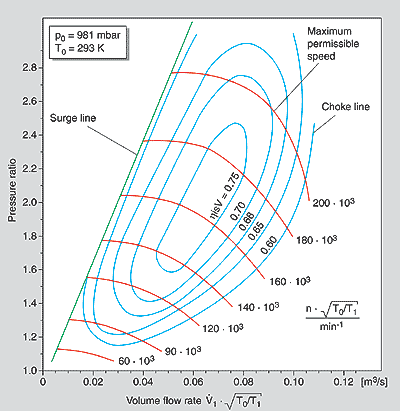Wuzak, on Jan 30 2011, 12:46, said:
So they don't need a wastegate at all?
So far there is only one gasoline engine that uses variable nozzle area instead of a wastegate, which can be found in the Porsche 911 Turbo.
gruntguru, on Jan 30 2011, 12:53, said:
To produce a flat torque curve the turbo needs to supply approximately constant boost ie a horizontal line on the compressor map. The surge line defines the low flow (low rpm) limit and the upper limit will usually be determined by falling efficiency (and sometimes by turbo speed limitation in higher boost applications). The width of the efficiency island can be tailored to the application - usually at the expense of a lower peak efficiency. The BMW torque range is about 4:1 which is pretty extreme. It could be achieved using the turbo in the map below at a PR of 1.8, but the power extending to 7,000 rpm would pass the 60% efficiency line on this map. So the BMW engine would require a broader compressor flow range or staged multiple turbos.

You have forgotten what impact the changing volumetric efficiency of the engine will have on what pressure ratio is needed to produce a flat torque curve. Usually the turbocharger and engine is designed in such a way that the pressure ratio can be decreased with increased engine speed as the engine is capable of reaching higher volumetric efficiencies by conventional means.
With direct injection and variable valve timing the valve overlap can also be increased at low engine speeds. This allows some charge air to pass though the engine which can be helpful to increase compressor flow and prevent surge at low speeds. So if you just have enough turbine power, increasing the compressor flow isn't that difficult.
gruntguru, on Jan 31 2011, 00:25, said:
As Dmitriy has pointed out, it is the region of constant power that determines the gear spacing required for best acceleration. In this case with constant power from 5,000 to 6,600 rpm the maximum ratio spacing should be 6600/5000 = 1.32 to avoid falling out of the max power region. A six speed box for example with this spacing would have an overall ratio span of 1.32^5 = 4.0.
Whiteblue, the twin scroll system is a divided inlet turbine system which utilises blowdown energy to produce more turbine energy or lower exhaust back pressure. This technology has been around for a long time. Although it can be used to produce boost from lower engine speeds, it does not reduce the need for a broader compressor map (quite the opposite in fact) so the map I posted above would not cover the range required for the BMW.
Without twin scroll it have also been common to use for instance 4-2-1 exhausts on turbocharged four cylinders, the benefits are similar to using twin scroll, but obviously the "leak" between the two sides are much larger when using a 4-2-1 exhaust and a single scroll turbocharger.
Wuzak, on Jan 31 2011, 06:36, said:
How do you get a broader compreesor map? Is it just detail design of the impeller, or do you need some sort of variable geometry to help with that?
The angle of the impeller blades are one factor, increased back angle tends to give a wider range at the cost of some higher turbocharger speed for a given pressure ratio. Another possebility is to give the compressor housing map width enhancement grooves (also refered to as inducer recirculating bypass). Close to surge some flow will then flow out of the impeller and back to the inlet via the groove and near choke some air will flow into the impeller via the groove.
Wuzak, on Feb 2 2011, 06:27, said:
Grunt, from the blurb WB posted above I gather that the twin scroll system is of benefit to an L4, or a flat plane V8 (one turbo per bank) because of valve timing and firing order. I take it that there would be little advantage for an L3 or twin turbo V6?
Twin scroll is an advantage when the engine have overlapping exhaust pulses.
WhiteBlue, on Feb 3 2011, 15:38, said:
It looks like GM is doing it already on their new Saab model.
It is still a compromise. To take advantage of the blowdown energy, the volume of the exhaust manifolds need to be small. When you're fitting one twin scroll turbo to a V6, this will require longer exhaust pipes, which increase the volume between the engine and the turbine. Using two turbochargers instead will give a smaller exhaust volume and less turbocharger inertia.
That engine was by the way introduced 2006 or so.
WhiteBlue, on Feb 3 2011, 19:17, said:
Systems with VTG and without waste gate are standard in diesels AFAIK. No reason they should not work in gas engines with some careful thermal management. And as I discussed above they should also work with twin scroll. So far I haven't heard an adamant point against that idea.
Diesels operate with much lower exhaust temperatures and increased engine load have a much smaller impact on the exhaust mass flow than with a gasoline engine which makes it a more suitable application for variable geometry turbines. Infact, diesels have in the past often used fixed geometry turbochargers without wastegates. A diesel doesn't have the same need to control the boost as a gasoline engine since the fuel flow doesn't follow air flow. Adding a wastegate, and later variable geometry, to the diesel engine turbocharger have however been helpful to improve low speed boost as the turbine and turbine housing can be made smaller.






























